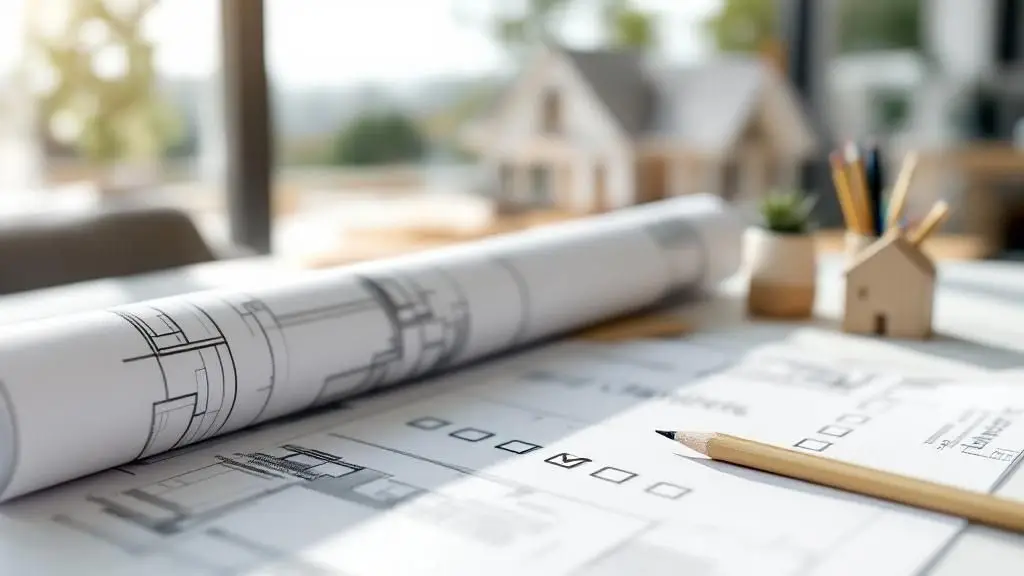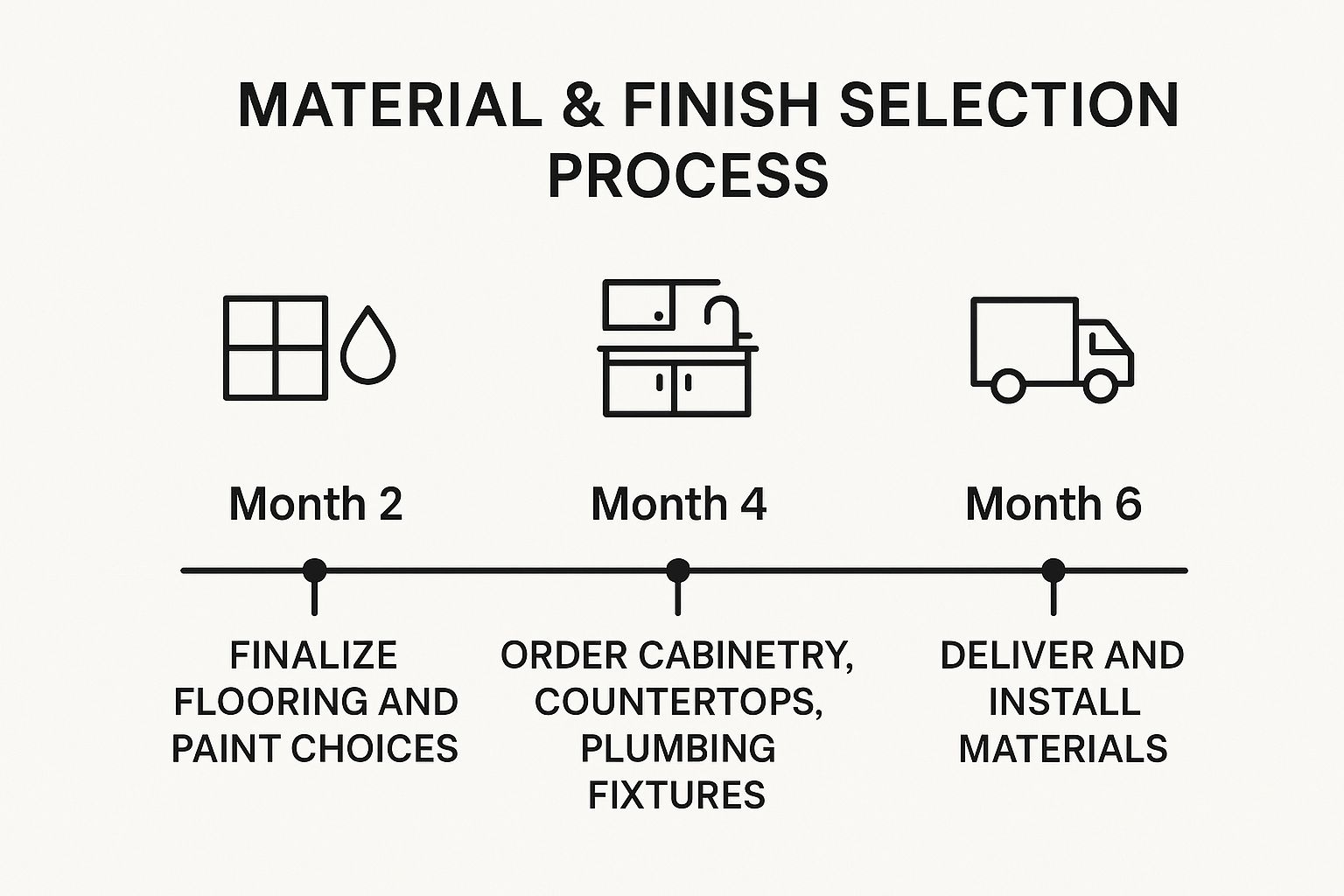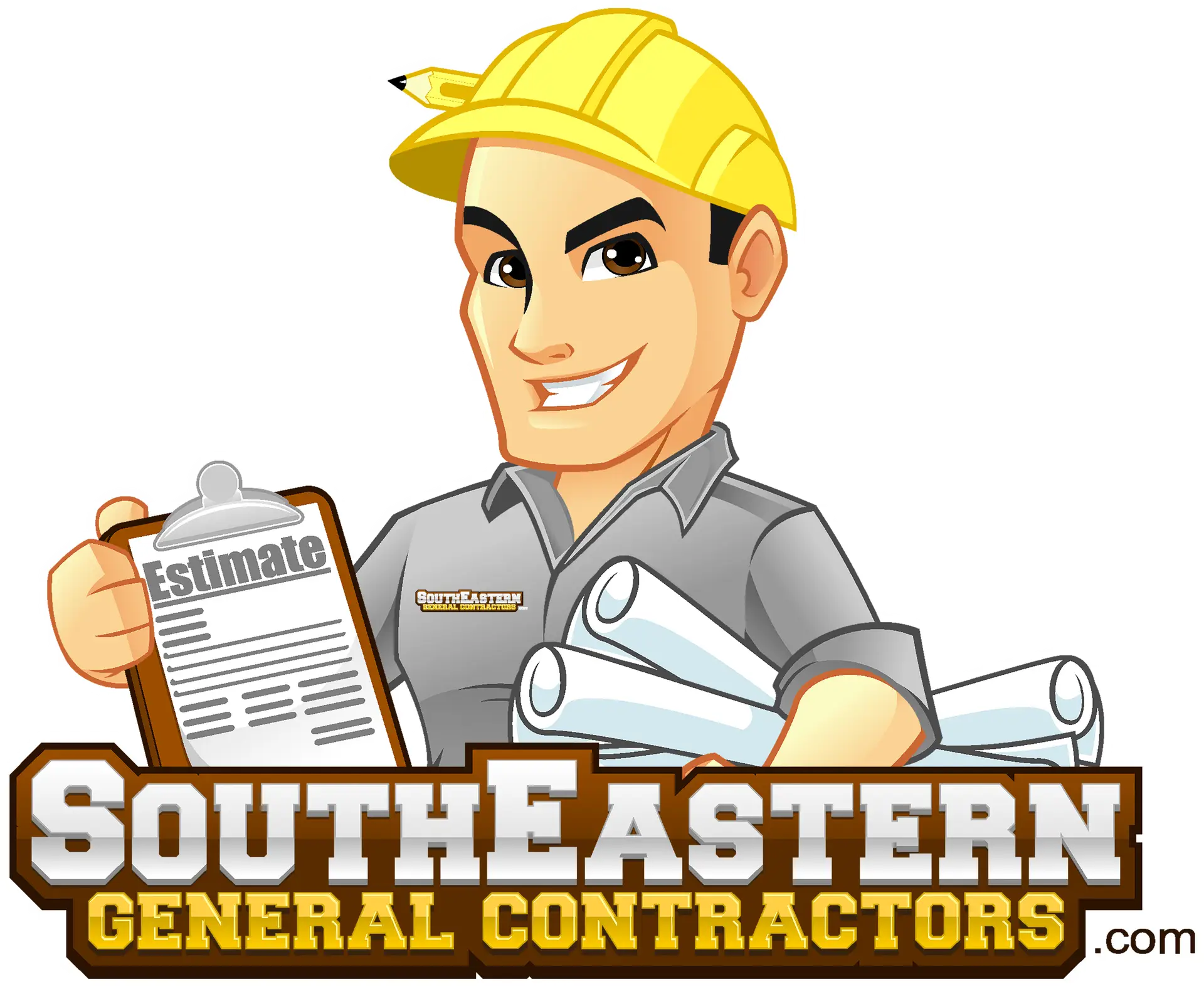
Your 2025 Building a Custom Home Checklist: 8 Key Phases
Embarking on the journey to build a custom home is one of life's most rewarding ventures. It's about more than just construction; it's about creating a space that perfectly reflects your family's story, lifestyle, and aspirations. But turning that dream board into a driveway requires a meticulous, battle-tested plan. This comprehensive building a custom home checklist is engineered to guide you through every critical decision, from securing financing to selecting the final doorknob.
As a proudly Native American-owned, 8(a), and HUBZone-certified firm, we at South Eastern General Contractors have spent over 21 years turning visions into realities for families across Fayetteville, Lumberton, and greater North Carolina. We anchor every project in trust, transparency, and an unwavering commitment to quality. Throughout this expert guide, we’ll share actionable insights from our local leadership, empowering you to navigate your build with confidence. We’re not just outlining steps; we’re giving you the framework to build a legacy, not just a structure.
1. Establish Your Budget and Secure Construction Financing
Before swooning over floor plans, the foundational first step is money. Nailing down your budget and securing financing isn't just a task on your building a custom home checklist; it's the bedrock upon which your entire dream will be built. A solid financial plan is the key to preventing your dream home from becoming a financial nightmare.

This process involves more than the sticker price. You must account for land, design fees, permits, utility connections, landscaping, and a non-negotiable contingency fund.
How to Build a Bulletproof Budget
- Calculate Total Project Cost: This includes "hard costs" (labor, materials) and "soft costs" (permits, architectural fees). For a deeper dive, explore this breakdown of custom home builder costs.
- The Golden Rule of Contingency: Earmark 10-20% of your total construction cost for a contingency fund. This is your safety net for unexpected issues or last-minute upgrades. For a $700,000 build, that means having $70,000 to $140,000 set aside.
Actionable Insight: Get pre-approved for your construction loan before shopping for land or interviewing builders. It demonstrates you're a serious buyer and defines your spending limit, preventing you from falling in love with a project you can't afford. This is a crucial step for building trust from the start.
Securing Your Construction Loan
A construction loan is a short-term loan paid out in stages ("draws") as work is completed. Most homeowners opt for a construction-to-permanent loan, which simplifies the process by converting into a traditional mortgage once the home is finished. While national banks offer these, don't overlook local lenders. As a trusted builder in the Fayetteville and Lumberton communities for over two decades, we've seen clients find fantastic rates and personalized service at local credit unions who understand the regional market. Compare at least three to four lenders to ensure you're getting the best terms for your legacy project.
2. Choose and Purchase the Right Lot
If the budget is the bedrock, the land is the literal ground your legacy will stand on. Choosing the right lot dictates your home's design, influences costs, and shapes your daily life. The wrong parcel can drain your budget with unforeseen expenses, while the perfect one makes the process smoother.
This phase of your custom home building checklist requires you to be a land detective. Location, topography, zoning, and utilities are critical clues to determine if your dream design is feasible.
How to Select the Perfect Parcel
- Analyze the Topography: A sloped lot in the Sandhills might offer stunning views but could require expensive grading and a specialized foundation. A flat lot might have drainage issues. Evaluating the land’s natural contours is crucial for estimating site prep costs.
- Verify Utilities Access: Don't assume you can just "plug in." For rural lots outside Fayetteville or Lumberton, you must confirm the cost and logistics of connecting to public water and sewer, or budget for a private well and septic system. We've seen clients save tens of thousands by verifying this access before closing the deal.
Actionable Insight: Visit a potential lot multiple times—in the morning, at dusk, and after a heavy rain. How does water drain? What is traffic like? For one of our clients building near the Cape Fear River, visiting after a storm revealed a low-lying area prone to pooling, a discovery that prompted a crucial adjustment to the home’s placement, saving them from future water issues.
Due Diligence Before You Buy
Before signing a purchase agreement, bring in professionals. A surveyor can mark property lines and identify easements. A geotechnical engineer should conduct a soil test, which is vital in our region of North Carolina. Poor soil might not support a standard foundation, requiring expensive solutions. This expert analysis ensures the land you love is ready to support the legacy you're building.
3. Hire the Right Team (Architect, Builder, Key Contractors)
Your team brings your vision to life. The right architect and a trustworthy builder are the most impactful decisions you'll make. This isn't just hiring help; it's about forming a partnership based on trust, communication, and a shared vision.

This dream team translates your ideas into architectural plans and then into a physical, legacy structure. Their ability to collaborate effectively will dictate the project's flow, budget adherence, and final quality.
How to Assemble Your Dream Team
- Interview at Least Three Candidates: For both architect and builder roles, interview at least three qualified candidates to compare styles, pricing, and personalities.
- Verify Credentials and Portfolios: Check licenses, confirm comprehensive insurance, and meticulously review portfolios. Explore our guide on how to find a good contractor for more tips.
- Check References Thoroughly: Call past clients and ask direct questions about their experience, communication, budget management, and how challenges were handled.
Actionable Insight: The best predictor of future performance is past behavior. Ask a builder's past clients this critical question: "If you were to build another custom home, would you hire them again without hesitation?" Their answer tells you everything. Our 21+ years of proven results in Fayetteville and Lumberton are built on earning a resounding "yes" to that question.
Fostering a Collaborative Partnership
The relationship with your builder is a long-term commitment. Clear, upfront communication protocols are the secret sauce. Establish how you'll receive updates, how change orders will be handled, and who your primary contact is. Choosing a builder with deep local roots and certifications like HUBZone and Native American-owned ensures they have established relationships with the best subcontractors and understand local permitting nuances, saving you time, money, and headaches.
4. Develop Detailed Architectural Plans and Engineering
This is where your dreams take shape as a concrete, buildable reality. This phase is an intense, creative collaboration to create blueprints so detailed they guide every single nail, pipe, and wire. This critical part of any building a custom home checklist ensures what’s built is exactly what you envisioned.
This process transforms your vision into a language every tradesperson on the job site understands, covering everything from the overall floor plan to the location of every light switch.
From Dream to Blueprint
- Design Inspiration & Wish Lists: Gather your ideas. Create Pinterest boards and make detailed lists of must-haves versus nice-to-haves. Clear examples give your design team a powerful starting point.
- Schematic Design & Revisions: Your architect will translate your wishes into initial floor plans and elevations. Don’t be shy about asking for changes; it’s far cheaper to move a wall on paper than once framing starts.
Actionable Insight: Request 3D renderings of key spaces. These visualizations are game-changers, allowing you to "walk through" your home virtually. For a recent project in Fayetteville, a 3D rendering helped our client realize their initial kitchen island design would impede traffic flow to the patio—a crucial catch that prevented a costly, post-construction regret.
The Engineering That Makes It Possible
While architecture is the art, engineering is the science ensuring your home is safe and sound. Your builder coordinates with structural, mechanical, electrical, and plumbing (MEP) engineers to integrate these critical systems. They ensure the foundation can support the home, the HVAC is properly sized, and everything exceeds local building codes. At SEGC, we see this as a crucial step in building a legacy home, guaranteeing it will stand strong for generations.
5. Obtain All Required Permits and Approvals
Navigating the labyrinth of local government is a critical checkpoint. Permitting ensures your new home is safe, structurally sound, and compliant with all regulations. Attempting to bypass this stage can lead to massive fines, work-stop orders, and even demolition.
This legal requirement is an indispensable part of any legitimate building a custom home checklist. It protects your investment by ensuring it's built to last and legally sound.
Navigating the Permitting Maze
- Jurisdictional Nuances: Requirements in Fayetteville can differ significantly from those in Lumberton. Building on the Carolina coast may require special approvals for hurricane resistance, while a historic district demands adherence to strict aesthetic guidelines.
- Complete Submissions are Key: The number one cause of delays is an incomplete or inaccurate application. Your builder should ensure every required document, from structural engineering reports to septic system designs, is professionally prepared.
Actionable Insight: Build a respectful relationship with local building officials. They are not adversaries; they are partners in ensuring a safe build. As a HUBZone-certified firm with deep roots in Fayetteville, our 21+ years of local leadership mean we’ve fostered these collaborative relationships, which often lead to smoother, more efficient approvals for our clients.
Timing and Strategy for Success
Permitting isn't an overnight process. A seasoned builder integrates this timeline into the overall project schedule. For our projects in the Fayetteville and Lumberton areas, our deep local experience allows us to manage this process efficiently, ensuring all legal requirements are met without unnecessary delays, reflecting our commitment to client trust and quality.
6. Plan and Design All Systems (Electrical, Plumbing, HVAC, Technology)
Now it’s time to give your home a nervous system. Planning your core systems—electrical, plumbing, HVAC, and technology—is a critical phase in any building a custom home checklist. It's about designing an integrated, high-performance machine that supports your lifestyle today and anticipates future needs.

This is where true customization shines. The behind-the-walls work separates a standard house from a thoughtfully engineered legacy home, ensuring comfort, efficiency, and future-readiness.
How to Engineer Your Home for Life
- Map Your Life: Use your furniture layout to dictate outlet placement. Where will your bedside lamps go? Your home office setup? Plan for outlets inside closets for charging vacuums and in pantries for small appliances.
- Future-Proof Your Power: Install more circuits than you currently need. This provides flexibility to add a workshop or an electric vehicle charger without a major electrical overhaul.
- Integrate for Comfort and Health: Consider an Energy Recovery Ventilator (ERV) paired with your HVAC for a constant supply of fresh, filtered air. For ultimate luxury, radiant floor heating in bathrooms provides unmatched silent, efficient warmth.
Actionable Insight: Don’t treat your systems as separate. Your builder should coordinate the plumber, electrician, and HVAC contractor early. One of our project managers, a 15-year veteran with SEGC, always insists on a "systems summit" before framing, where all trades map out their runs on the actual subfloor. This simple, proactive step prevents conflicts and ensures every system is installed optimally.
Investing in Resilience and Technology
Modern life demands more. In communities like Fayetteville and Lumberton, where storms are a reality, a whole-house generator with an automatic transfer switch provides immense peace of mind. For technology, structured wiring with a central hub creates a powerful network backbone for smart home devices and streaming. This is how you build a home that’s not just smart, but wise.
7. Select All Materials, Finishes, and Fixtures
If designing the floor plan is writing the script, selecting materials is casting the actors and designing the sets. This is where your home's personality comes to life. Every choice contributes to the daily experience of living in your custom sanctuary.
This stage is a thrilling part of any building a custom home checklist. It involves hundreds of decisions balancing aesthetics, function, and budget. Finalizing these selections on time is critical to keeping the construction schedule moving smoothly.
How to Curate Your Home's Palette
- Create a Master Selections Sheet: Work with your builder to create a comprehensive spreadsheet listing every item that needs a decision, with deadlines for each choice.
- Experience Materials in Person: Never finalize a major finish from a thumbnail. Visit showrooms to see large samples. Take them to your lot to observe them in natural light.
- Balance Splurges and Savings: You might splurge on high-end fixtures for the primary bathroom but opt for budget-friendly options in secondary baths. It's about strategic allocation.
- Order a Surplus: Always order 10% extra of flooring and tile. This "attic stock" is invaluable for future repairs.
Actionable Insight: Making all selections before construction gets too far along is one of the most effective ways to control your budget and timeline. Changes made mid-build, known as change orders, are a primary source of budget overruns. Lock in your choices early to protect your investment. We build this into our process to honor our commitment to client trust and delivering on our promises.
Sticking to a Selections Timeline
Material selection is a phased process. Items with long lead times, like custom cabinetry or specialty windows, must be ordered months in advance. As builders with over two decades of experience in the Fayetteville area, we guide our clients through a structured timeline to prevent any bottlenecks.

The key takeaway is that major decisions for foundational elements like flooring happen early, while items with significant manufacturing lead times, such as cabinetry and countertops, are ordered mid-way through the process to align with the interior finishing stage.
8. Develop Construction Timeline and Manage the Build Process
With your design finalized, it's time to shift from planning to execution. Your role transitions to that of an informed project manager alongside your builder. A realistic timeline and active management are key. This is the dynamic phase where your paper plans transform into a physical legacy.
This is a marathon, not a sprint. A well-managed build is the difference between an exciting journey and a stressful experience. Your builder leads the charge, but your active participation is vital.
How to Stay in Control of Your Build
- Establish a Communication Rhythm: Set up a weekly progress meeting with your general contractor. This is your time to review what was accomplished, what’s next, and address concerns. At SEGC, we use tools like CoConstruct and create video walkthroughs to provide clients with a real-time window into their project's progress.
- Embrace Milestone Inspections: While your builder and local officials conduct mandatory inspections, consider hiring a third-party inspector for key milestones like framing and pre-drywall for an added layer of quality assurance.
Actionable Insight: Visit the job site regularly, but schedule these visits with your builder. This respects the workflow and ensures safety. A testimonial from a recent client in Lumberton praised our scheduled weekly site walks: "It made me feel like part of the team, not an interruption. I always knew what was happening and why."
Navigating the Construction Timeline
Building a custom home in the Fayetteville or Lumberton area can take anywhere from 9 to 18 months, depending on size, complexity, and weather. Be prepared for potential delays; they are a normal part of construction. The hallmark of a great builder, a value we've honed over 21+ years, is not the absence of problems but the ability to communicate them early and provide effective solutions. For a deeper understanding of project oversight, explore our guide on how to manage construction projects on southeasterngc.com.
8-Step Custom Home Checklist Comparison
| Item | Implementation Complexity 🔄 | Resource Requirements ⚡ | Expected Outcomes 📊 | Ideal Use Cases 💡 | Key Advantages ⭐ |
|---|---|---|---|---|---|
| Establish Your Budget and Secure Construction Financing | High — involves detailed budgeting and loan approval processes, inspections | Significant financial resources including down payment and contingency funds | Clear financial boundaries, realistic project timelines, funding flexibility | Early stages of home building; ensures financial feasibility and planning | Prevents overspending, flexible staged funding |
| Choose and Purchase the Right Lot | Moderate — requires surveys, tests, and regulatory reviews | Requires specialist services for soil, topography, utilities assessments | Optimal site selection impacting cost, value, and feasibility | When selecting location with consideration to terrain, utilities, zoning | Tailored lot choice, potential for higher property value |
| Hire the Right Team (Architect, Builder, Contractors) | Moderate to High — vetting, coordinating multiple professionals | Skilled professionals, licensing and insurance verification | Quality construction, expert design, smooth project execution | Essential for complex or custom projects needing expert oversight | Prevents mistakes, access to professional networks |
| Develop Detailed Architectural Plans and Engineering | High — detailed drawings, engineering specs, multiple revisions | Architects, engineers, design software, time | Accurate, code-compliant blueprints guiding construction | Custom designs requiring optimization, safety, and permits | Prevents costly changes, optimizes space and safety |
| Obtain All Required Permits and Approvals | Moderate — navigating regulatory processes and inspections | Administrative effort, fees, professional plans submission | Legal compliance, construction approval, timely inspections | Mandatory for all projects; critical in regulated or sensitive zones | Ensures legal protection, avoids costly work stoppages |
| Plan and Design All Systems | High — coordination among specialized trades, system calculations | Engineering expertise, materials, technology planning | Integrated, efficient electrical, plumbing, HVAC, and smart systems | For technologically advanced or high-performance homes | Prevents system conflicts, improves energy efficiency |
| Select All Materials, Finishes, and Fixtures | Moderate — making numerous detailed selections with budget and timeline constraints | Access to showrooms, vendor coordination, budget allocation | Customized aesthetics and durable finishes aligned with lifestyle | Finalizing interior and exterior design elements | Personalization, cost savings via bulk purchasing |
| Develop Construction Timeline and Manage the Build Process | High — ongoing scheduling, coordination, inspections, and issue resolution | Time investment, management tools, regular communication | On-time completion, quality control, budget adherence | Throughout construction phase to maintain schedule and quality | Reduces delays, ensures work quality, legal documentation |
Your Legacy Awaits: Building More Than Just a Home
You now have the ultimate blueprint for your custom home adventure. This isn't just a list; it’s a strategic guide, a comprehensive building a custom home checklist designed to transform a daunting process into a series of achievable, empowering steps. From securing permits to selecting doorknobs, each item is a critical piece of the puzzle. The real magic happens when you view this process as the creation of a personal sanctuary and a tangible piece of your legacy.
The Power of Partnership and Precision
The most crucial takeaway is partnership. The relationship you build with your contractor is the foundation upon which your home rests. A great builder is more than a contractor; they are your advocate, problem-solver, and trusted guide.
This is a principle we live by at SEGC. With over 21 years of proven results serving communities like Fayetteville and Lumberton, we’ve seen firsthand how a collaborative, transparent approach makes all the difference. Our commitment to client trust is why we meticulously document the process, ensuring you remain in complete control from start to finish. Our Native American-owned heritage informs our long-term view: we are building legacies, not just structures.
Expert Insight: The success of your custom home build is directly proportional to the quality of communication and trust you establish with your builder. It is the single most important decision you will make.
From Checklist to Completed Dream Home
So, what's next? Use this checklist as your roadmap.
- Revisit Phase One: Solidify your budget and vision. How will this space serve your family a decade from now?
- Begin Your Research: Start identifying potential lots and interviewing builders. Look for a team whose values align with yours.
- Embrace the Journey: Building a custom home is a marathon. Celebrate the small victories.
Building a home is one of life's most significant endeavors. By following a detailed building a custom home checklist and partnering with a team dedicated to quality and integrity, you are not just building a structure. You are crafting a legacy.
Ready to turn your checklist into a cornerstone? At South Eastern General Contractors, our mission is to build legacies. Our unique 8(a) and HUBZone certifications reflect our commitment to excellence and community impact in places like Fayetteville and Lumberton. We build every home as if it were our own. Visit South Eastern General Contractors to see how our 21+ years of proven results and dedication to client partnership can help you build your legacy, together.



